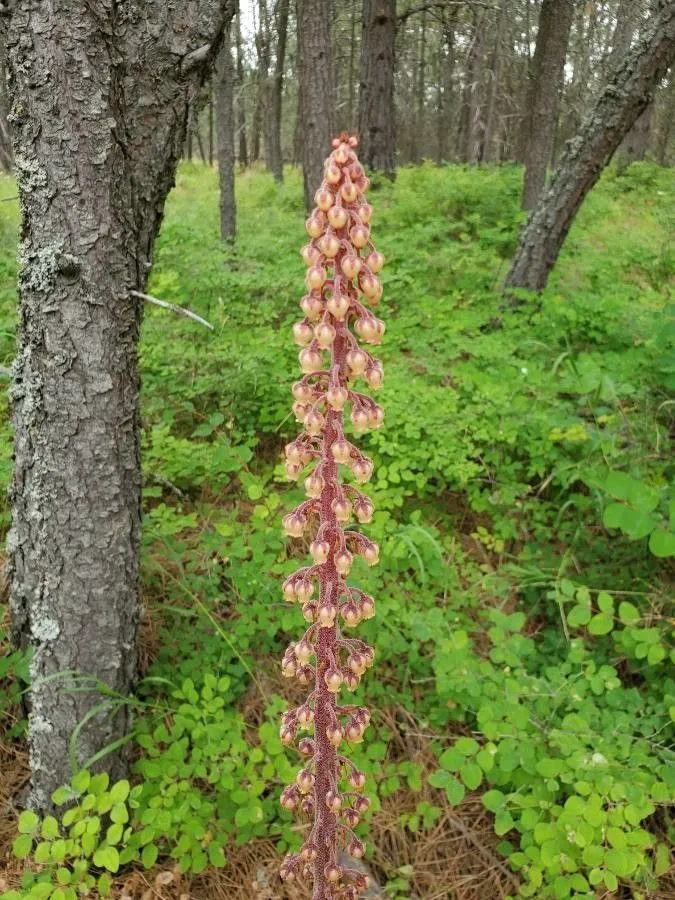
Author: Nutt.
Bibliography: Gen. N. Amer. Pl. 1: 269 (1818)
Year: 1818
Status: accepted
Rank: species
Genus: Pterospora
Vegetable: False
Observations: Alaska to Canada and Mexico
Pine-drops, scientifically known as Pterospora andromedea, is a unique and fascinating plant with a rich botanical history. It was described by Thomas Nuttall, an eminent botanist, in the seminal work “Genera of North American Plants” published in 1818. This publication has made a significant impact on the study and classification of North American flora.
Pine-drops belong to the Ericaceae family, which includes other well-known plants such as blueberries, cranberries, and heathers. One of the most intriguing aspects of Pine-drops is its distribution across North America. It can be found from the cold, rugged terrains of Alaska, stretching through the diverse landscapes of Canada, and reaching as far south as Mexico. This extensive range showcases its adaptability to various climatic conditions.
Unlike most plants within the Ericaceae family, Pine-drops are mycoheterotrophic, meaning they rely on a symbiotic relationship with fungi for their nutritional needs rather than photosynthesis. This fascinating survival strategy involves forming connections with mycorrhizal fungi, which in turn associate with the roots of nearby trees. Through these fungal networks, Pine-drops can access carbohydrates and nutrients indirectly sourced from the host trees, making it an important component of its native ecosystems.
The physical appearance of the Pine-drops also sets it apart. It features tall, reddish stems that emerge from the forest floor, adorned with small, scale-like leaves and clusters of delicate, urn-shaped flowers. These flowers typically bloom in the summer, adding a splash of color to the understory of coniferous forests where they are often found.
In conclusion, Pine-drops (Pterospora andromedea) is not only a botanical marvel due to its symbiotic relationships and unique survival strategies but also an important constituent of the ecological tapestry stretching from Alaska to Mexico. Its discovery and classification by Thomas Nuttall have allowed botanists and nature enthusiasts to gain insight into the complexities and wonders of plant life within the vast expanse of North America.
Eng: giant bird’s nest, giant pinedrops, pine-drops, woodland pinedrops, pinedrops, giant bird’s-nest
Fra: ptérospore à fleurs d’andromède, ptérospore andromède
En: Pine-drops, Woodland pinedrops, Giant bird’s nest, Giant pinedrops, Pinedrops, Giant bird’s-nest
Fr: Ptérospore à fleurs d’andromède, Ptérospore andromède
Nv: Ndoochííʼ
Ru: Птероспора
Taken Jul 25, 2022 by Ethan Greer (cc-by-sa)
Taken Jul 25, 2022 by Ethan Greer (cc-by-sa)
Taken Jun 28, 2021 by Felicia Flerchinger (cc-by-sa)
Taken Aug 2, 2022 by Cynthia Finigan (cc-by-sa)
Taken Jul 23, 2012 by EOL − Ken-ichi Ueda (cc-by-nc)
Taken Jul 27, 2013 by EOL − Sam McNally (cc-by-nc)
Taken Jul 3, 2020 by Linda Racicot (cc-by-sa)
Taken Sep 4, 2020 by Valerie Mason (cc-by-sa)
Taken Nov 4, 1999 by EOL − Gerald and Buff Corsi (cc-by-nc-sa)
Taken Jul 14, 2019 by Jessica Jessica (cc-by-sa)
Taken Feb 16, 2016 by EOL − Steven Thorsted (cc-by-nc)
Taken Oct 12, 2020 by Benjamin Hamilton (cc-by-sa)
Taken Jun 25, 2015 by EOL − avocat (cc-by-nc)
Taken Sep 4, 2020 by Valerie Mason (cc-by-sa)
Taken Jun 28, 2015 by EOL − Gary Griffith (cc-by-nc-sa)
Taken Mar 17, 2013 by EOL − John Brew (cc-by-sa)
Taken Jun 29, 2015 by EOL − Damon Tighe (cc-by-nc)
Taken Aug 27, 2015 by EOL − Damon Tighe (cc-by-nc)
Taken May 15, 2009 by EOL − Barry Rice (cc-by-nc-sa)
Taken Oct 26, 2015 by EOL − Keir Morse (cc-by-nc-sa)
Taken Aug 8, 2019 by Adrien Arrous (cc-by-sa)
Growth habit>: Forb/herb
Family: Myrtaceae Author: (F.Muell.) K.D.Hill & L.A.S.Johnson Bibliography: Telopea 6: 402 (1995) Year: 1995 Status:…
Family: Rubiaceae Author: Pierre ex A.Froehner Bibliography: Notizbl. Bot. Gart. Berlin-Dahlem 1: 237 (1897) Year:…
Family: Sapindaceae Author: Koidz. Bibliography: J. Coll. Sci. Imp. Univ. Tokyo 32(1): 38 (1911) Year:…
Family: Asteraceae Author: A.Gray Bibliography: Pacif. Railr. Rep.: 107 (1857) Year: 1857 Status: accepted Rank:…
Family: Fabaceae Author: Medik. Bibliography: Vorles. Churpfälz. Phys.-Ökon. Ges. 2: 398 (1787) Year: 1787 Status:…
Family: Aspleniaceae Author: (Cav.) Alston Bibliography: Bull. Misc. Inform. Kew 1932: 309 (1932) Year: 1932…